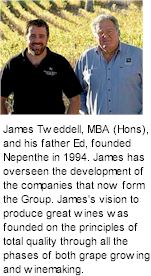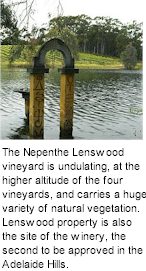


Up in the cool heights of the Adelaide Hills, Nepenthe have been producing some soul reposing potions of their own, uncompromising wines of outstanding quality and internationally recognised distinction. Wines that, strangely enough, have been impressing both critics and consumers with their varietal faithfulness and subtle Adelaide Hills nuances.

In 1994, the Tweddell family purchased a premium property in the sub-region of Lenswood in the Adelaide Hills. The property was carefully selected and planted to 24 hectares of vines with the intent of producing premium wine. Proven varieties such as Pinot Noir, Chardonnay and Sauvignon Blanc were planted, as well as interesting varieties such as Zinfandel and Pinot Gris. In 1996, Nepenthe received approval to build its winery, only the second in the Adelaide hills at the time (the first being Petaluma in 1978)
From the beginning, Nepenthe were receiving positive review from the press and numerous medals on the show circuit. In the first few vintages, Nepenthe wines featured in James Halliday's Top 100, The UK Times Top 100, The Advertiser Top 100, The International Wine Challenge as well as many other feature media articles.
In 1997 Nepenthe acquired a property in Charleston within the Adelaide Hills and has planted a further 43 hectares of vineyard. Then in 2002 a 25 hectare vineyard was acquired in Balhannah (where the cellar door is located), and in 2005 Nepenthe acquired its latest vineyard, 38 hectares in Hahndorf. Nepenthe also sources fruit from a variety of vineyards throughout the hills. Most fruit Nepenthe receives is managed by Nepenthe Viticulture, ensuring that Nepenthe only receives the highest quality fruit to make award winning wines.

The Nepenthe Lenswood vineyard is undulating, at the higher altitude of the four vineyards, and carries a huge variety of natural vegetation. With under half of the property cleared, Lenswood constitutes a number of small vineyards separated by tracts of natural scrub which is heritage listed. The winery has been purpose built to give the winemaking team the ultimate flexibility, allowing them to make the multi award winning wines year after year.
Offering a north easterly aspect, and with sweeping views of the Mount Lofty escarpment, the Charleston vineyard also features a magnificent old Devon farm house built in 1842 from Cobb (a mixture of mud and straw on a stone base). The barn, stables and shearing shed make for a great location for Nepenthe wine related dinners and tastings. All of the buildings are on the State Heritage register, and have been meticulously restored.
The Charleston vineyard site was specifically chosen because of it's outstanding viticultural qualities. The Charleston Vineyard is also home to Nepenthe Viticulure's base in the Adelaide Hills.
The 25 hectare Balhannah vineyard, is located on rolling hills mid-way between Balhannah and the historic town of Hanhdorf. It is here that the Nepenthe cellar door facility is located, offering a warm and cosy welcome in winter and a wonderful summer entertainment facility with spectacular views of the Mount Lofty ranges.
